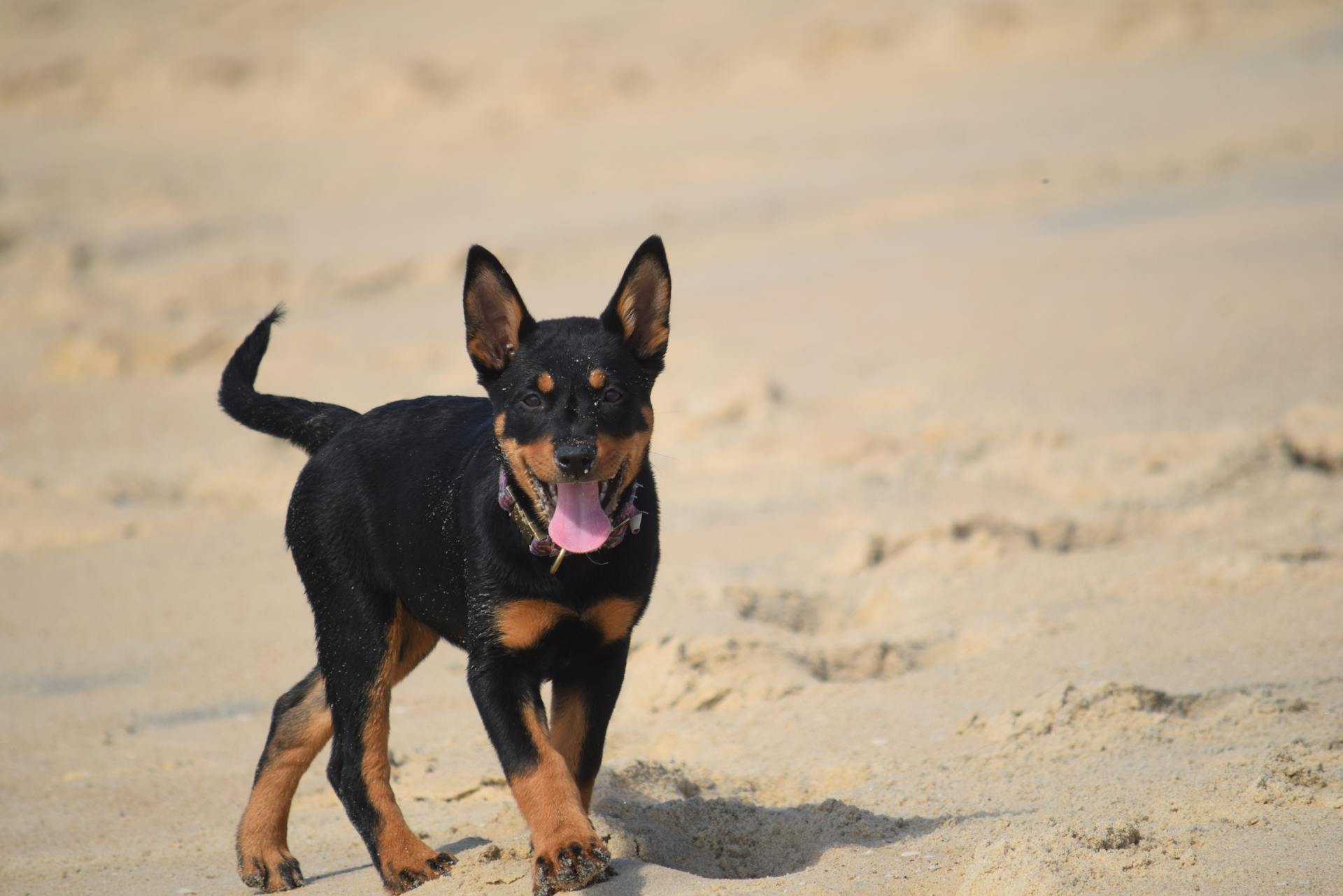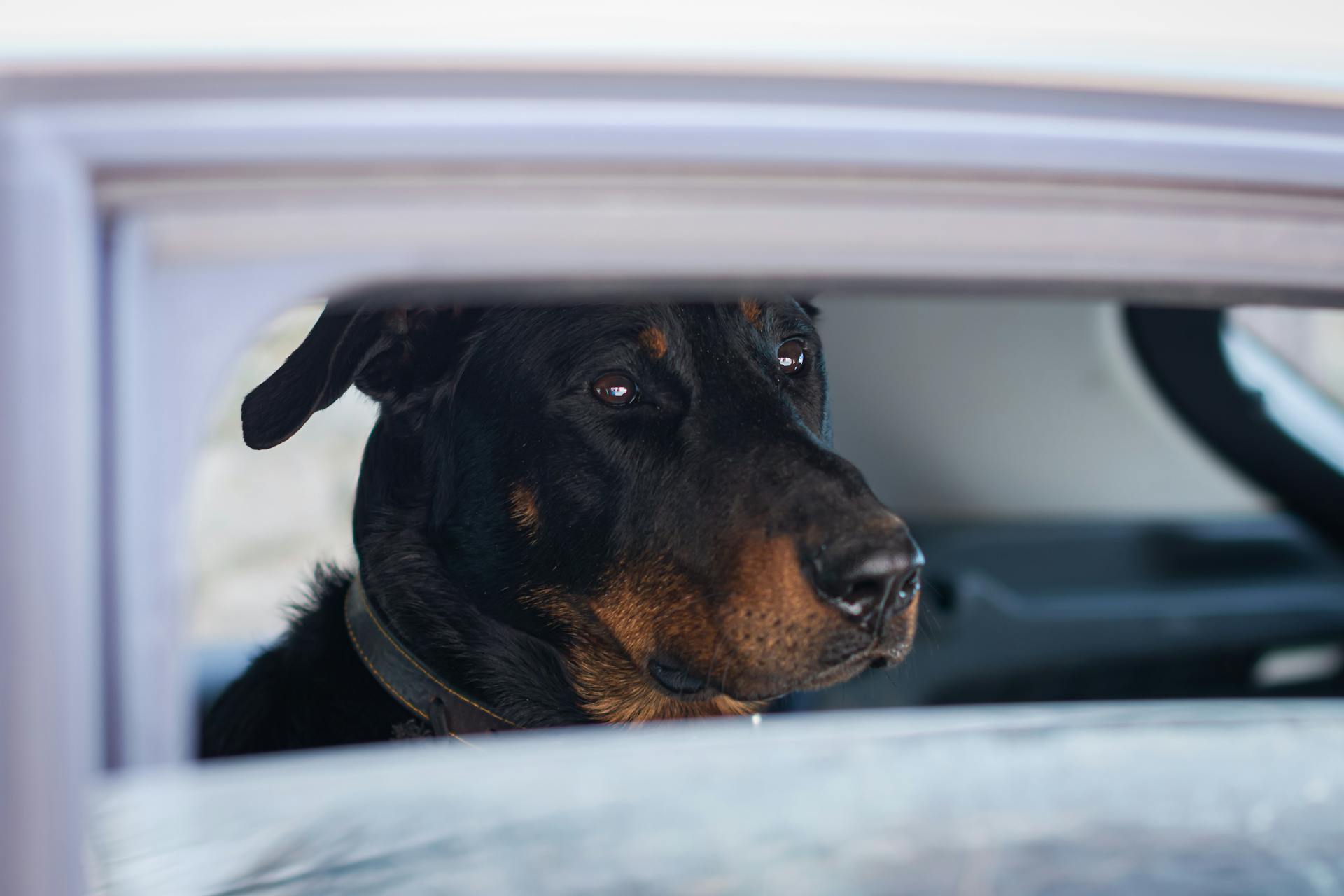
The Beauceron is a versatile breed with a rich history dating back to the 16th century. Originally bred to guard sheep and drive cattle, this intelligent and athletic dog has evolved into a loyal companion and effective protection dog.
They are naturally protective of their families, but proper training and socialization can help them distinguish between threats and harmless strangers. With early training, they can learn to be gentle with children and other pets.
Their medium to large size, ranging from 22 to 27 inches in height, makes them a formidable presence without being intimidating. Their short, dense coat requires minimal grooming, making them a practical choice for active families.
In terms of exercise needs, Beaucerons require regular physical activity to stay happy and healthy, but they don't need as much as some other high-energy breeds. A daily walk and playtime should suffice, but they'll appreciate longer runs or hikes if you're up for it.
Physical Characteristics
The Beauceron is a physically imposing breed, weighing in at 70–110 pounds and standing between 24–28 inches tall. Their muscular build is evident in their sleek, yet thick, physique.
Their distinctive coloring is a major head-turner, with a classic black and "squirrel red" tuxedo being the most common combination. They can also be found in shades of gray-black with tan and harlequin patterns.
The Beauceron's coat is mostly short, but they have areas of fringe and thickness on their neck and back legs that can reach over 1 inch in length. This unique feature adds to their rugged appearance.
Their long, thick tail curves into a slight j-shape, complementing their streamlined physique. It's a distinctive feature that's hard to miss.
Beaucerons have large, long heads with ears that can be naturally set, hanging loose, or cropped. However, it's worth noting that cropping is a contentious issue, with no proven health benefits and potential pain for the pup.
Care and Maintenance
Your Beauceron will need regular nail trims to prevent them from breaking, splitting, or becoming ingrown. They also shed quite a bit, especially during seasonal changes, so be prepared for weekly, or even daily, brushing sessions.
Their short, thick coats have two layers, making them easy to bathe, but regular dematting under the belly is a must to prevent matting and tangling. Beaucerons typically weigh between 70-110 pounds and stand at an average height of 25-28 inches for males and 24-27 inches for females.
To keep your Beauceron happy and healthy, they require daily opportunities to use their natural abilities to sniff, herd, and chase. A regular schedule that includes an enrichment routine is crucial to their health and wellbeing.
Beaucerons are extremely devoted to their family, but this devotion also means they need a strict routine and can become stressed and anxious when their environment changes. They do best with high-quality dog food, whether commercially manufactured or home-prepared with your veterinarian's guidance.
Additional reading: How Much Exercise Do Border Collies Need
Their diet should be tailored to their age and current weight, with careful attention given to fast-growing puppies who may need additional calories during rapid-growth phases. Beaucerons that spend their days working alongside devoted owners may require additional nutrition or supplements to ensure proper growth, development, and maintenance of their bones and joints.
Health
The Beauceron is a healthy breed with an average lifespan of 10–12 years. They need lots of exercise to stay trim and fit, so be prepared to take them on long walks, runs, and play fetch with them daily.
Beaucerons are prone to bloat, a life-threatening stomach condition that can happen suddenly. Make sure to educate yourself on the symptoms and talk to your vet about prevention.
Hip dysplasia is another issue that can affect Beaucerons, so it's essential to check with your breeder about recent OFA testing. This includes checks for heart, eye, and thyroid disease.
Regular ear checks are crucial to ensure your Beauceron's ears stay clean and healthy. Brush their teeth often to prevent dental problems.
Here are some common health issues that can affect Beaucerons:
- Bloat and GDV
- DCM
- Hip Dysplasia
- Canine Copper-Associated Hepatitis
History and Origins
The Beauceron has a rich history dating back to the 1800s as a multipurpose dog developed in France.
Originally bred to drive cattle and sheep across the plains of La Beauce, the Beauceron became a popular breed by the early 1800s.
Their first recognized public appearance as an established breed was in 1863 at the Universal Exposition in Paris.
The French army began to utilize the Beauceron during both World Wars, where they excelled as bomb detection dogs and messengers.
Today, Beaucerons are still used as military dogs and police dogs.
They remained one of the rarest breeds until 2007, when they were officially recognized by the American Kennel Club, ranking as the 156th most popular breed.
Curious to learn more? Check out: Why Are Labrador Retrievers so Popular
Temperament and Training
Beaucerons are smart, self-assured, and loving dogs that make wonderful companions for those who can take them to work or have a flexible schedule.
They're adaptable and take changes in stride, but can be standoffish when meeting new people.
Beaucerons are easy to train, eager to learn, and enjoy mentally stimulating activities, making them a great fit for experienced dog owners.
With love and positive reinforcement training techniques, puppies learn incredibly quickly and are motivated by praise, toys, and treats.
Beaucerons are natural watchdogs, but they're not prone to excessive barking, which is a big plus for families who value a quiet home.
Their high prey drives and herding tendencies mean they need solid training to keep them focused and obedient.
What Makes a Good Guard
A good guard dog is loyal to their family and protective of them. They are naturally wary of strangers and will alert their owners to any potential threats.
Loyal and protective instincts are key characteristics of a good guard dog. According to Gina DiNardo, executive secretary at the American Kennel Club (AKC), guard dogs have a protective instinct for their families, honed over hundreds of years.
Take a look at this: Are Border Collies Loyal
To be effective, a guard dog must be alert to sounds and changes in the environment. This allows them to let their owners know when anyone comes onto their property.
The best guard dog breeds meet certain criteria, including being loyal to their family, protective of family, reserved with strangers, and alert to sounds and changes in the environment. Here are some of the key characteristics of a good guard dog:
Beaucerons, in particular, are known for their loyal and protective nature. They are intelligent, fearless, and calm, making them excellent guard dogs.
Family and Ownership
The Beauceron is a natural guardian that is intelligent, fearless, and calm.
They're very devoted to their owners and easy to train. This makes them a great choice for families who are willing to put in the effort to train them.
Beaucerons are exceptional pets for families, being protective, devoted, and great with children.
They're active and smart, so they do best in homes where they get lots of mental stimulation and exercise. If they don't get enough, they can become destructive.
A Beauceron would enjoy an adventurous life with an active family, and they need plenty of exercise to thrive.
A different take: Kuvasz vs Great Pyrenees
Puppies and Breeding
Beauceron puppies are very energetic but generally well-behaved, particularly when getting enough physical activity and playtime.
Puppies benefit from early training, and most can start learning basic commands such as come and sit when they’re about 8 weeks old or so.
Because Beaucerons can be protective and have strong prey drives, early training and socialization are essential.
They’re rare outside of France, so it can be challenging to locate puppies.
There aren’t many breeders working with the dogs, so be prepared to do some legwork to find a puppy.
Breed clubs and organizations like the AKC are good places to get started.
Explore further: When Are Border Collies Fully Grown
Frequently Asked Questions
Are Beaucerons good service dogs?
Beaucerons can make excellent service dogs due to their physical strength and coordination, making them well-suited for tasks that require assistance with mobility and physical tasks. They can provide valuable support for individuals with mobility impairments.
What are the cons of a Beauceron dog?
Beaucerons may be prone to health issues such as hip dysplasia, bloat, and heart problems, making regular veterinary check-ups essential. Responsible ownership requires awareness of these potential cons to ensure a long and healthy life for your Beauceron
Featured Images: pexels.com
